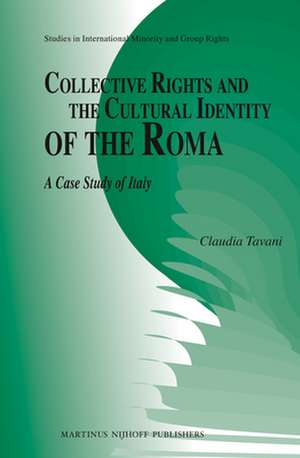Collective Rights and the Cultural Identity of the Roma: A Case Study of Italy: Studies in International Minority and Group Rights, cartea 3
Autor Claudia Tavanien Limba Engleză Hardback – 2 sep 2012
Preț: 1104.77 lei
Preț vechi: 1347.28 lei
-18% Nou
Puncte Express: 1657
Preț estimativ în valută:
211.42€ • 229.57$ • 177.60£
211.42€ • 229.57$ • 177.60£
Carte indisponibilă temporar
Doresc să fiu notificat când acest titlu va fi disponibil:
Se trimite...
Preluare comenzi: 021 569.72.76
Specificații
ISBN-13: 9789004202610
ISBN-10: 9004202617
Pagini: 382
Dimensiuni: 155 x 235 x 25 mm
Greutate: 0.75 kg
Editura: Brill
Colecția Brill | Nijhoff
Seria Studies in International Minority and Group Rights
ISBN-10: 9004202617
Pagini: 382
Dimensiuni: 155 x 235 x 25 mm
Greutate: 0.75 kg
Editura: Brill
Colecția Brill | Nijhoff
Seria Studies in International Minority and Group Rights
Notă biografică
Claudia Tavani, Ph.D. (2010) in Law, University of Essex, cooperates with various non-governmental organisations and universities, including the University of Cagliari. Her research interests are cultural rights, cultural identity, protection of minorities, non-discrimination, collective rights and human rights in general.
Cuprins
Acknowledgements;
Abstract; List of Abbreviations; Introduction
Book Outline;
1 Chapter I: An overview of the Roma and their culture
1.1 Introduction: the importance of recognising the Roma as an ethnic group;
1.2 Culture and cultural identity;
1.3 Historical background;
1.4 The Roma today: main characteristics and identification;
1.5 Conclusions: the Roma as an ethnic and transnational minority;
2 Chapter II: The definition of minority and the protection of Roma in international law instruments
2.1 Introduction;
2.2 Article 27 International Covenant on Civil and Political Rights;
2.3 International Labour Organisation Convention 169 on Indigenous and Tribal Peoples;
2.4 The 2005 United Nations Declaration on the Rights of Indigenous Peoples;
2.5 The Organisation for Security and Cooperation in Europe;
2.6 The Council of Europe and the Framework Convention for the Protection of National Minorities;
2.7 The European Charter for Regional of Minority Languages;
2.8 Conclusions;
3 Chapter III: The protection of minority rights through individual human rights
3.1 Introduction;
3.2 The principles of equality and non-discrimination as a full realisationof the rights of minorities;
3.3 The protection of minorities in the European Union;
3.4 The United Nations instruments and their jurisprudence ;
3.5 The European Convention on Human Rights and the Framework Convention for the Protection of National Minorities;
3.6 Conclusions: de facto equality, affirmative action and special measures as ways to protect minorities;
4 Chapter IV: Individual v. Collective rights
4.1 Introduction;
4.2 The added value of collective rights;
4.3 The protection of collective rights in international instruments;
4.4. The debate between supporters and critics of collective rights;
4.5 Collective rights and cultural identity? ;
5 Chapter V: The case of Italy
5.1 Introduction;
5.2 Background information on the Roma in Italy;
5.3 The Italian legal system;
5.4 The juridical status of the Roma in Italy;
5.5 Measures “in favour” of the Roma?;
5.6 Conclusions and final remarks;
Conclusions; Appendix I ; Appendix II; Appendix III ; Appendix IV ; Appendix V; Bibliography; Table of Cases; Index.
Abstract; List of Abbreviations; Introduction
Book Outline;
1 Chapter I: An overview of the Roma and their culture
1.1 Introduction: the importance of recognising the Roma as an ethnic group;
1.2 Culture and cultural identity;
1.3 Historical background;
1.4 The Roma today: main characteristics and identification;
1.5 Conclusions: the Roma as an ethnic and transnational minority;
2 Chapter II: The definition of minority and the protection of Roma in international law instruments
2.1 Introduction;
2.2 Article 27 International Covenant on Civil and Political Rights;
2.3 International Labour Organisation Convention 169 on Indigenous and Tribal Peoples;
2.4 The 2005 United Nations Declaration on the Rights of Indigenous Peoples;
2.5 The Organisation for Security and Cooperation in Europe;
2.6 The Council of Europe and the Framework Convention for the Protection of National Minorities;
2.7 The European Charter for Regional of Minority Languages;
2.8 Conclusions;
3 Chapter III: The protection of minority rights through individual human rights
3.1 Introduction;
3.2 The principles of equality and non-discrimination as a full realisationof the rights of minorities;
3.3 The protection of minorities in the European Union;
3.4 The United Nations instruments and their jurisprudence ;
3.5 The European Convention on Human Rights and the Framework Convention for the Protection of National Minorities;
3.6 Conclusions: de facto equality, affirmative action and special measures as ways to protect minorities;
4 Chapter IV: Individual v. Collective rights
4.1 Introduction;
4.2 The added value of collective rights;
4.3 The protection of collective rights in international instruments;
4.4. The debate between supporters and critics of collective rights;
4.5 Collective rights and cultural identity? ;
5 Chapter V: The case of Italy
5.1 Introduction;
5.2 Background information on the Roma in Italy;
5.3 The Italian legal system;
5.4 The juridical status of the Roma in Italy;
5.5 Measures “in favour” of the Roma?;
5.6 Conclusions and final remarks;
Conclusions; Appendix I ; Appendix II; Appendix III ; Appendix IV ; Appendix V; Bibliography; Table of Cases; Index.
Recenzii
"Die Untersuchung zeigt auf interessante Weise nicht nur die im Hinblick auf die Roma als Minderheit gegenwärtig bestehenden Probleme, sondern auch wie diesen rechtlich begegnet werden kann."
Sabine Scharnagl, Newsletter Menschenrechte, 3/2013-Literatur, pp. 223-224, Österreichisches Institut für Menschenrechte.
Sabine Scharnagl, Newsletter Menschenrechte, 3/2013-Literatur, pp. 223-224, Österreichisches Institut für Menschenrechte.











